Trees, Shrubs and Woody Vines
Media
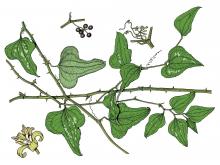
Species Types
Scientific Name
Smilax bona-nox
Description
Catbrier is a green-stalked perennial vine with stout spines. It climbs up to 25 feet using tendrils that arise in pairs from the bases of the triangular, heart, or fiddle-shaped leaves.
Media
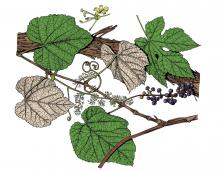
Species Types
Scientific Name
Vitis aestivalis
Description
Summer grape is a vigorous, woody, wild grapevine climbing to a height of 35 feet. It grows mostly in the southern two-thirds of Missouri, often in drier situations than many other grape species.
Media

Species Types
Scientific Name
Vitis cinerea
Description
Winter grape is a wild grapevine that can climb up to 50 feet. It occurs in low woods and along streams, in thickets, and in fencerows. It’s common in the southern two-thirds of Missouri.
Media

Species Types
Scientific Name
Vitis vulpina
Description
Frost grape is a vigorous vine climbing to 60 feet in length using tendrils. It is scattered statewide, growing in bottomlands, along streams, in low, wet woods, at bases of bluffs, and in thickets.
Media
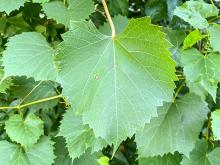
Species Types
Scientific Name
Vitis species
Description
Eight species of grapes in the genus Vitis are native or naturalized in Missouri. All bear edible fruits. Like their relatives elsewhere, they have important connections to humans and to nature.
Media

Species Types
Scientific Name
Quercus spp.
Description
Oaks are the most important group of trees in Missouri, in both human and ecosystem value. They dominate most of the forests, woodlands, and savannas in the state. Learn more about our 22 species.
Media
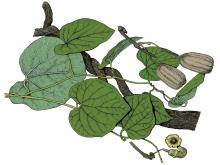
Species Types
Scientific Name
Aristolochia tomentosa
Description
Woolly pipe-vine is a high-climbing woody vine common along streams in the Ozarks. Hikers and canoeists often don’t notice it because the leaves and unusual flowers are usually high overhead in the trees.
Media

Species Types
Scientific Name
Cocculus carolinus
Description
Carolina moonseed is a slender, twining vine. It is scattered in southern and eastern Missouri. It bears clusters of bright red, somewhat flattened fruits. The disk-shaped seeds are spiraled like a snail shell.
Media
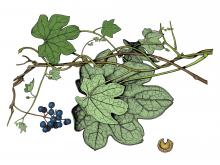
Species Types
Scientific Name
Menispermum canadense
Description
Common moonseed is a rather slender, twining vine that climbs or sprawls. It occurs nearly statewide. It bears clusters of bluish-black fruits. The seeds are flattened, with a raised edge shaped like a crescent moon.
Media

Species Types
Scientific Name
Rubus occidentalis
Description
Black raspberries resemble blackberries, but when ripe, the fruits fall away as a caplike unit from the receptacle. Leaflets appear white underneath. The canes are whitish-coated when young; they arch down and take root at the tips. Native and scattered statewide.
See Also
About Trees, Shrubs and Woody Vines in Missouri
There are no sharp dividing lines between trees, shrubs, and woody vines, or even between woody and nonwoody plants. “Wood” is a type of tissue made of cellulose and lignin that many plants develop as they mature — whether they are “woody” or not. Trees are woody plants over 13 feet tall with a single trunk. Shrubs are less than 13 feet tall, with multiple stems. Vines require support or else sprawl over the ground.





















